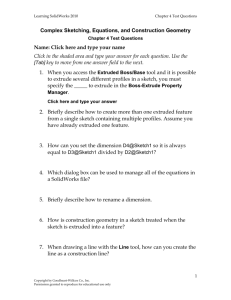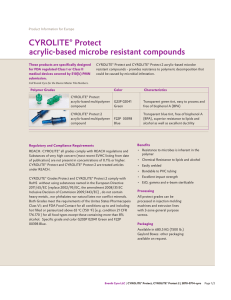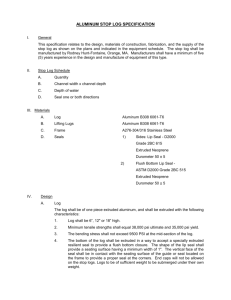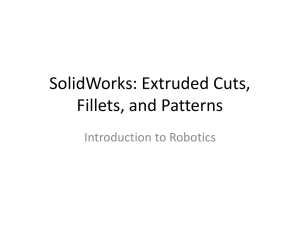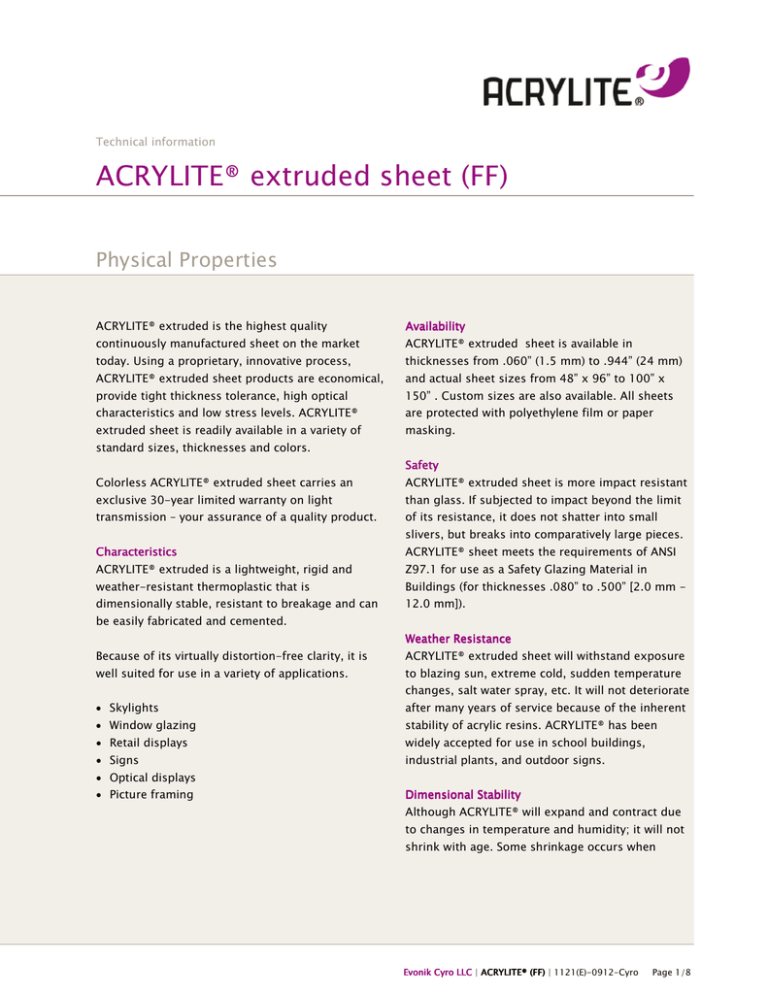
Technical information
ACRYLITE® extruded sheet (FF)
Physical Properties
ACRYLITE® extruded is the highest quality
Availability
continuously manufactured sheet on the market
ACRYLITE® extruded sheet is available in
today. Using a proprietary, innovative process,
thicknesses from .060” (1.5 mm) to .944” (24 mm)
ACRYLITE® extruded sheet products are economical,
and actual sheet sizes from 48” x 96” to 100” x
provide tight thickness tolerance, high optical
150” . Custom sizes are also available. All sheets
characteristics and low stress levels. ACRYLITE®
are protected with polyethylene film or paper
extruded sheet is readily available in a variety of
masking.
standard sizes, thicknesses and colors.
Safety
Colorless ACRYLITE® extruded sheet carries an
ACRYLITE® extruded sheet is more impact resistant
exclusive 30-year limited warranty on light
than glass. If subjected to impact beyond the limit
transmission – your assurance of a quality product.
of its resistance, it does not shatter into small
slivers, but breaks into comparatively large pieces.
Characteristics
ACRYLITE® sheet meets the requirements of ANSI
ACRYLITE® extruded is a lightweight, rigid and
Z97.1 for use as a Safety Glazing Material in
weather-resistant thermoplastic that is
Buildings (for thicknesses .080” to .500” [2.0 mm -
dimensionally stable, resistant to breakage and can
12.0 mm]).
be easily fabricated and cemented.
Weather Resistance
Because of its virtually distortion-free clarity, it is
ACRYLITE® extruded sheet will withstand exposure
well suited for use in a variety of applications.
to blazing sun, extreme cold, sudden temperature
changes, salt water spray, etc. It will not deteriorate
• Skylights
after many years of service because of the inherent
• Window glazing
stability of acrylic resins. ACRYLITE® has been
• Retail displays
widely accepted for use in school buildings,
• Signs
industrial plants, and outdoor signs.
• Optical displays
• Picture framing
Dimensional Stability
Although ACRYLITE® will expand and contract due
to changes in temperature and humidity; it will not
shrink with age. Some shrinkage occurs when
Evonik Cyro LLC | ACRYLITE® (FF) | 1121(E)-0912-Cyro
Page 1/8
ACRYLITE® is heated to forming temperature, but
post-forming stability is excellent.
All thermoplastic materials, including ACRYLITE®
extruded sheet, will gradually lose tensile strength
Light Weight
as the temperature approaches the maximum
ACRYLITE® sheet is only half the weight of glass and
recommended for continuous service–160°F (71°C).
43% the weight of aluminum.
Expansion and Contraction
Rigidity
Like most other plastics, ACRYLITE® extruded sheet
ACRYLITE® sheet is not as rigid as glass or metals.
will expand and contract from 3 to 8 times as much
However, it is more rigid than many other plastics
as glass or metals. The designer should be aware of
such as acetates, polycarbonates or vinyls. Under
its coefficient of expansion and make appropriate
wind load an acrylic sheet will bow and foreshorten
provisions. A 48” panel will expand and contract
as a result of deflection.
approximately .002” for each degree fahrenheit
change in temperature. In outdoor use, where
For glazing installations the maximum wind load
summer and winter temperatures differ as much as
and the size of the window must be considered
100°F, a 48” sheet will expand and contract
when the thickness of a panel is to be determined.
approximately 3/16”. Sash rabbets must be of
sufficient depth to allow for expansion as well as for
If ACRYLITE® sheet is formed into corrugated or
contraction.
domed shapes, rigidity will be increased and
deflection minimized.
ACRYLITE® extruded sheet also absorbs water when
exposed to high relative humidity, resulting in
Cold Flow
expansion of the sheet. At relative humidity of
Large, flat ACRYLITE® sheet, if insufficiently
100%, 80%, and 60%, the dimensional changes are
supported, may deform permanently due to
0.6%, 0.3% and 0.2%, respectively.
continuous loads such as snow, or even their own
weight. Increased rigidity obtained by forming will
Heat Resistance
minimize cold flow.
ACRYLITE® extruded sheet can be used at
temperatures from -30°F (-34°C) up to +190°F
Strength and Stresses
Stresses
(+88°C), depending on the application. It is
Although the tensile strength of ACRYLITE®
recommended that temperatures not exceed 160°F
extruded is 10,000 psi (69 Mpa) at room
(71°C) for continuous service, or 190°F (88°C) for
temperature (ASTM D 638), stress crazing can be
short, intermittent use. Components made of
caused by continuous loads below this value. For
ACRYLITE® should not be exposed to high heat
glazing applications, continuously imposed design
sources such as high wattage incandescent lamps,
loads should not exceed 750 psi (5.2 Mpa) at 73°F
unless the finished product is ventilated to permit
(23°C). Temporary loads of up to 1,500 psi (10.4
the dissipation of heat.
Mpa) may be imposed for short durations of time at
73°F (23°C).
Light Transmission
Clear, colorless ACRYLITE® extruded sheet has a
Localized, concentrated stresses must be avoided.
light transmittance of 92%. It is warranted not to
For this reason, and because of thermal expansion
lose more than 3% of its light-transmitting ability in
and contraction, large sheets should never be
a 30-year period. Contact Evonik Cyro LLC for the
fastened with bolts, but should always be installed
complete warranty.
in frames.
Evonik Cyro LLC | ACRYLITE® (FF) | 1121(E)-0912-Cyro
Page 2/8
ACRYLITE® UV filtering (OP3) sheet is formulated
infrared heaters while clamped in a horizontal
with ultraviolet absorbers designed to help protect
frame, it may be necessary to control the heaters
pictures, photographs and posters from the
above the center of the sheet. This will prevent the
damaging effects of ultraviolet light. ACRYLITE® UV
center from becoming too hot and sagging under
filtering (OP3) sheet absorbs more than 98% of the
its own weight.
radiation in the ultraviolet range below 400
nanometers.
The sheet will exhibit very little “memory” after
forming and probably will not return to its original
Chemical Resistance
flat condition if reheated.
ACRYLITE® extruded has excellent resistance to
many chemicals including:
ACRYLITE® extruded sheet will shrink in the
• solutions of inorganic alkalies such as ammonia
machine direction when heated without a frame.
• dilute acids such as sulfuric acid up to a
Sheet thicknesses of .118” (3.0 mm) and greater will
concentration of 30%
• aliphatic hydrocarbons such as hexane and VM&P
shrink no more than 3%. Thinner thicknesses could
shrink more.
naphtha
Cutting and Machining
ACRYLITE® extruded sheet is not attacked by most
ACRYLITE® extruded sheet can be sawed with
foods and foods are not affected by it.
circular saws or band saws. It can be drilled, routed,
It is attacked, in varying degrees, by:
filed and machined much like wood or brass with a
• aromatic solvents such as benzene and toluene
slight modification of tools. Because the sheet
• chlorinated hydrocarbons such as methylene
softens quickly, it is necessary to keep the cutting
chloride and carbon tetrachloride
tool and machined edge of the sheet as cool as
• ethyl and methyl alcohols
possible. Cooling of the cutting tool is
• some organic acids such as acetic acid
recommended. Tool sharpness and “trueness” are
• lacquer thinners, esters, ketones and ethers
essential to prevent gumming, heat buildup and
For a listing of the resistance of ACRYLITE® sheet to
stresses in the part. Heat buildup at the machined
more than 60 chemicals, refer to the table on page
edge could lead to subsequent stress crazing and
6.
therefore must be avoided.
Formability
Laser Cutting
ACRYLITE® extruded sheet will soften as the
Laser technology is ideal for quick and accurate
temperature is increased above 195°F (91°C). As the
cutting, welding, drilling, scribing and engraving of
temperature is increased the sheet passes through
plastics. CO2 lasers focus a large amount of light
the thermo-elastic state to the thermoplastic state.
energy on a very small area which is extremely
The change is gradual rather than sharply defined.
effective for cutting complex shapes in acrylic
The forming temperature range is between 290°F
sheet. The laser beam produces a narrow kerf in the
and 320°F (143°C and 160°C). Because the sheet
plastic allowing for close nesting of parts and
gradually becomes thermoplastic, certain
minimal waste. CO2 lasers vaporize the acrylic as
procedures should be considered during
they advance resulting in a clean polished edge but
thermoforming. If the sheet is to be hung in an
with high stress levels; annealing acrylic sheet after
oven, it is necessary to use a continuous clamp
laser cutting is recommended to minimize the
rather than several individual clamps. This will
chance of crazing during the service life of the part.
prevent the sheet from permanently deforming
between clamps. If the sheet is to be heated by
Evonik Cyro LLC | ACRYLITE® (FF) | 1121(E)-0912-Cyro
Page 3/8
Cementing
various building codes, these tests do not duplicate
ACRYLITE® sheet can be cemented using common
actual fire conditions.
solvent cements or polymerizable cements such as
ACRIFIX®. The most critical factor is good edge
The thermal conductivity of a material–its ability to
preparation of the part to be cemented. The edge of
conduct heat–is called k-Factor. The k-Factor is an
the sheet must be properly machined in order to
inherent property of the material, and is
have a square flat surface and no stresses.
independent of its thickness and of the
Annealing of the part prior to cementing is
surroundings to which it is exposed. The k-Factor
recommended. Cement and cement fumes should
of ACRYLITE® sheet is:
not contact formed or polished surfaces.
1.3 B.T.U. / (hour) (sq. ft.) (°F/inch) or 0.19 W /m. K
Annealing
ACRYLITE® extruded sheet may be annealed at
Whereas the k-Factor is a physical property of the
180°F (82°C) with the heating and cooling times
material, the U-Factor—or overall coefficient of heat
determined by the sheet thickness. An approximate
transfer—is the value used to calculate the total
guideline is annealing time in hours equals the
heat loss or gain through a window.
sheet thickness in millimeters and the cool-down
period is a minimum of 2 hours ending when sheet
The U-Factor is the amount of heat per unit time
temperature falls below 140°F. For example, 1/8”
and area which will pass through a specific
(3mm) ACRYLITE® sheet would be heated for 3
thickness and configuration of material per degree
hours at 180°F (82°C) and slowly cooled for 3 hours.
of temperature difference on each of its two sides.
This value takes into account the thickness of the
Flammability
Flammability
sheet, whether the sheet is in a horizontal or
ACRYLITE® is a combustible thermoplastic.
vertical position, as well as the wind velocity.
Precautions should be taken to protect this material
U-Factors are based on specific conditions (e.g.,
from flames and high heat sources. ACRYLITE®
single-glazed or double-glazed installations) and
sheet usually burns rapidly to completion if not
are different for summer and winter.
extinguished. The products of combustion, if
sufficient air is present, are carbon dioxide and
Listed below are U-Factors for several thicknesses
water. However, in many fires sufficient air will not
of ACRYLITE® sheet for single-glazed, vertical
be available and toxic carbon monoxide will be
installations, based on the standard ASHRAE*
formed, as it will when other common combustible
summer and winter design conditions.
materials are burned. We urge good judgment in
the use of this versatile material and recommend
U-Factors—
Factors—BTU/hour sq. ft. F° (w/m² x K)
that building codes be followed carefully to assure
ACRYLITE® extruded
it is used properly.
Thermal Conductivity
The combustibility test data for ACRYLITE® sheet is:
self-ignition temperature (ASTM D-1929) is 850°F
Sheet Thickness
Thickness
Summer
Winter
Conditions
Conditions
mm
inches
3.0
.118
0.98 (5.56)
1.06
(6.02)
4.5
.177
0.94 (5.34)
1.02
(5.79)
6.0
.236
0.90 (5.11)
0.97
(5.51)
9.5
.375
0.83 (4.71)
0.89
(5.05)
(455°C), smoke density as measured by ASTM D2843 is 6.4%, and the rate of burning as measured
by ASTM D-635 is 1.0 in/min (25mm/min) for 1/8”
(3mm) thick sheet. While these data are based on
small scale laboratory tests frequently referenced in
Evonik Cyro LLC | ACRYLITE® (FF) | 1121(E)-0912-Cyro
Page 4/8
*American Society of Heating, Refrigerating and Air-Conditioning
Engineers
The total heat loss or gain through a window (due
to temperature difference only) can be calculated by
multiplying the area of the window, times the
difference between indoor and outdoor
temperatures, times the appropriate U-Factor (from
Table above). Heat intake through solar radiation
must be added to arrive at the total heat gain.
ACRYLITE® extruded sheet is a better insulator than
glass. Its U-Factor or overall coefficient of heat
transfer is approximately 10% lower than that of
glass of the same thickness. Conversely, its RTFactor is about 10% greater.
Thermal Shock and Stresses
ACRYLITE® extruded sheet is more resistant than
glass to thermal shock and to stresses caused by
substantial temperature differences between a
sunlit and a shaded area of a window or by
temperature differences between opposite surfaces
of a window.
sheet. The code used to describe chemical
resistance is as follows:
R= Resistant
ACRYLITE® extruded sheet only withstands this
substance for long periods and a temperature of
120°F (49°C).
LR= Limited Resistance
ACRYLITE® extruded sheet only resist the action of
this substances for a short periods at room
temperatures. The resistance for particular
application must be determined.
N= Non Resistant
ACRYLITE® extruded sheet is not resistance to this
substance. It is swelled, attacked, dissolved, or
damaged in some manner. Plastic materials can be
attacked by chemicals in several ways. The methods
of fabrication and/or conditions of exposure of
ACRYLITE® sheet, as well as the manner, in which
the chemical are supplied, can influence the final
results even for “R” coded chemicals. Some of these
factors are listed below:
Surface Hardness
Fabrication-Stress
generated while sawing, sanding,
Fabrication
The surface of plastic is not as hard as that of glass.
machining, drilling, and/or forming.
Therefore, reasonable care should be exercised in
handling and cleaning ACRYLITE® sheet.
ExposureExposure Length of exposure, stresses induced
during the life of the product due to various loads,
Electrical Properties
changes in temperatures, etc.
ACRYLITE® sheet has many desirable electrical
properties. It is a good insulator. Its surface
Application of ChemicalsChemicals by contact, rubbing,
resistivity is higher than that of most plastics.
wiping, spraying, etc.
Continuous outdoor exposure has little effect on its
electrical properties.
Chemical Resistance
Resistance
The table on the next page gives an indication of
the chemical resistance of ACRYLITE® extruded
The table should therefore be used as only a
general guide and, in case of doubt; it should be
supplemented by tests made under actual working
conditions.
Evonik Cyro LLC | ACRYLITE® (FF) | 1121(E)-0912-Cyro
Page 5/8
Chemical Resistance of Clear ACRYLITE®
Chemical
Code
Chemical
Code
Chemical
Code
Acetic Acid (5%)
LR
Ethyl Alcohol (30%)
LR
Nitric Acid (Conc.)
N
Acetic Acid (Glacial)
N
Ethyl Alcohol (95%)
N
Oleic Acid
R
Acetone
N
Ethylene Dichloride
N
Olive Oil
R
Ammonium Chloride
R
Ethylene Glycol
R
Phenol Solution (5%)
N
Ammonium Hydroxide (10%)
R
Gasoline
LR
Soap Solution (Mild dish soap) R
Ammonium Hydroxide (Conc.)
R
Glycerine
R
Sodium Carbonate (2%)
R
Aniline
N
Heptane
R
Sodium Carbonate (20%)
R
Battery Acid
R
Hexane
R
Sodium Chloride (10%)
R
Benzene
N
Hydrochloric Acid
R
Sodium Hydroxide (1%)
R
Butyl Acetate
N
Hydrofluoric Acid (25%)
N
Sodium Hydroxide (10%)
R
Calcium Chloride (Sat.)
R
Hydrogen Peroxide (<40%)
R
Sodium Hydroxide (60%)
R
Calcium Hypochlorite
R
Hydrogen Peroxide (>40%)
LR
Sodium Hypochlorite (5%)
R
Carbon Tetrachloride
N
Isopropyl Alcohol
LR
Sulfuric Acid (3%)
R
Chloroform
N
Kerosene
R
Sulfuric Acid (30%)
R
Chromic Acid
LR
Lacquer Thinner
N
Sulfuric Acid (Conc.)
N
Citric Acid (20%)
R
Methyl Alcohol (30%)
LR
Toluene
N
Cottonseed Oil (Edible)
R
Methyl Alcohol (100%)
N
Transformer Oil
R
Detergent Solution (Heavy Duty)
R
Methyl Ethyl Ketone (MEK)
N
Trichloroethylene
N
Diesel Oil
R
Methylene Chloride
N
Turpentine
R
Dimethyl Formamide
N
Mineral Oil
R
Water
R
Dioctyl Phthalate
N
Nitric Acid (10%)
R
Xylene
N
Ethyl Acetate
N
Nitric Acid (40%)
LR
Evonik Cyro LLC | ACRYLITE® (FF) | 1121(E)-0912-Cyro
Page 6/8
Physical Characteristics of ACRYLITE®
Property
Property(a)
Mechanical
ASTM Method
Typical Value
Value ( 0.250“ Thickness) (b)
Specific Gravity
D 792
1.19
Tensile Strength
D 638
10,000 psi (69 MPa)
Elongation, Rupture
4.5%
Modulus of Elasticity
Flexural Strength
400,000 psi (2800 MPa)
D 790
17,000 psi ( 117 MPa)
Compressive Strength ( Yield)
D 695
17,000 psi (117 MPa)
Impact Strength
D 256
0.4 ft. lbs/in. of notch
Rockwell Hardness
D 785
M-93
Barcol Hardness
D 2583
48
Refractive Index
D 542
1.49
Light Transmission, Total
D 1003
92%
Forming Temperature
-
Approx. 300°F (149°C)
Deflection Temperature
D 648
195°F (91°C)
Vicat Softening Point
D 1525
220°F (105°C)
Maximum recommended Continuous
-
(c) (71°C)
160°F(c)
D 696
0.000040 in/in - °F
Cenco-Fitch
1.3 BTU/ (Hr) (Sq. Ft.) (°F / in.) (0.19 w/m•K)
D 635
1.0 in/min.
D 1929
850°F(455°C)
Modulus of Elasticity
480,000 psi (3300 MPa)
Izod Milled Notch
Optical
Thermal
(21.6 J/m of notch)
under load, 264 psi
Service Temperature
Coefficient of Linear
Thermal Expansion
Coefficient of
(0.000072 m/m - °C)
Thermal Conductivity
Flammability, Burning Rate
( 0.125”thickness)
Self Ignition Temperature
(25 mm/min.)
Specific Heat @ 77°F
Electrical
0.35 BTU/(Ib.) (°F)(1470J/Kg•K)
Smoke Density Rating
D 2843
4.8%
Dielectric Strength Short Time ( 0.125”)
D 149
430 volts/mil (17 KV/mm)
Dielectric Constant
D 150
60 Hertz
3.6
1,000 Hertz
3.3
1,000,000 Hertz
Dissipation Factor
2.8
D 150
60 Hertz
0.06
1,000 Hertz
0.04
1,000,000 Hertz
0.02
Volume Resistivity
D 257
1016ohm-cm
Surface Resistivity
D 257
1016ohms
D 570
0.2%
Water Absorption
24 hrs @ 73°F
Odor
-
-
Taste
-
-
(a) Typical values; should not be used for specification purposes.
(b) Values shown are for 0.250” thickness. Some values will change with thickness or pigmentation.
(c) It is recommended that temperatures not exceed 160°F for continuous service, or 190°F for short intermittent use.
Evonik Cyro LLC | ACRYLITE® (FF) | 1121(E)-0912-Cyro
Page 7/8
Evonik Cyro LLC | ACRYLITE® (FF) | 1121(E)-0912-Cyro
Page 8/8
This information and all further technical advice is based on our present knowledge and experience. However, it implies no liability or
other legal responsibility on our part, including with regard to existing third party intellectual property rights, especially patent rights.
In particular, no warranty, whether expressed or implied, or guarantee of product properties in the legal sense is intended or implied.
We reserve the right to make any changes according to technical progress or further developments. The customer is not released from
the obligation to conduct careful inspection and testing of incoming goods. Performance of the product described herein should be
verified by testing, which should be carried out only by qualified experts in the sole responsibility of a customer. Reference to trade
names used by other companies is neither a recommendation, nor does it imply that similar products should be used.
Evonik Industries is a worldwide manufacturer of PMMA products sold under the ACRYLITE® trademark in the Americas and under the
PLEXIGLAS® trademark in the European, Asian, African, and Australian continents. ©Evonik Cyro LLC. All rights reserved.
Printed in the USA.
Evonik Cyro LLC
299 Jefferson Road, Parsippany, NJ 07054 US
Phone +1800 631 5384
www.acrylite.net www.acrylite-shop.com
Evonik Cyro LLC | ACRYLITE® (FF) | 1121(E)-0912-Cyro
Page 8/8

